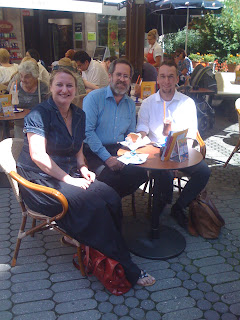John Oleson and I discussing the Humayma report.
I mostly put aside any further work on the Gustaf Dalman volumes, but continued to work some evenings on the captions for Humberto da Silveira’s Masjid al-Aqsa book. I also proofread the latest issue of Near Eastern Archaeology, and finished proofreading the Lot’s Cave excavation report, so these days were particularly productive. I can tell whether I am having an especially productive day, if I can motivate myself to work the full morning long until lunch at 2:00 without stopping to take a nap.
Muhammad Ghosheh was also around in Amman once again and he came by ACOR a few times to discuss his Dome of the Rock book that he is preparing. One evening he, Ali Bawwab, a Jordanian scholar interested in Jerusalem, and I went out for dinner.
Muhammad Ghosheh and Ali Bawwab
Among other social activities, on September 21 John Oleson gave a public lecture at ACOR about Roman architectural disasters, which was followed by a reception. The German Institute also hosted a reception on September 28. Also on Friday September I joined the Friends of Archaeology trip to sites on the south side of Amman, some of which I had not been to before. This was the first time I had been on a Friends’ trip for some years. We went to see an Iron Age site at Mabraq, another Iron Age site at Qasr Irmidan, then the Roman necropolis at the Cave of the Sleepers site, important in the Islamic tradition, a Roman temple converted into a church at Khuraybat al-Suq, a Roman mausoleum at Qasr al-Radinah and finally the Umayyad palace at Mshatta.
Owen Chesnut and Christoph Eger, two scholars at ACOR these days, at one of the Roman rock-cut tombs at the Cave of the Sleepers site.
The Friends of Archaeology group at Mshatta, in front of the recently reconstructed arches.












